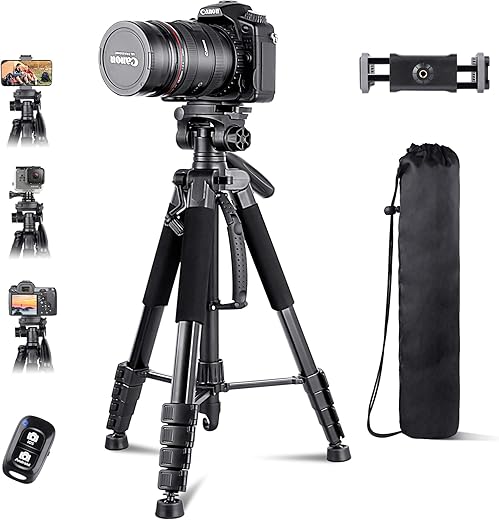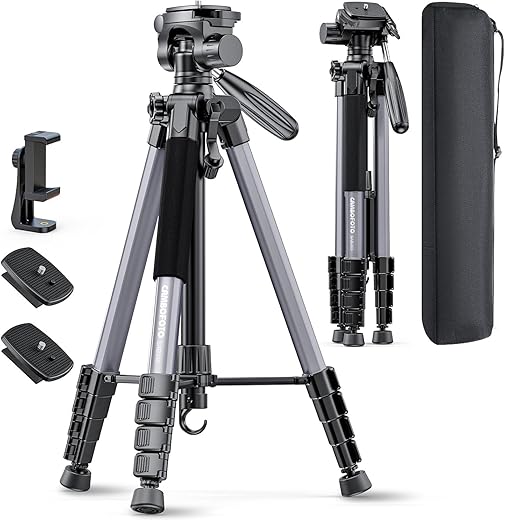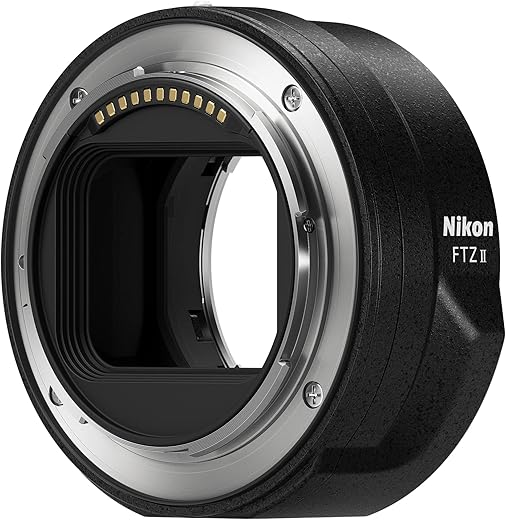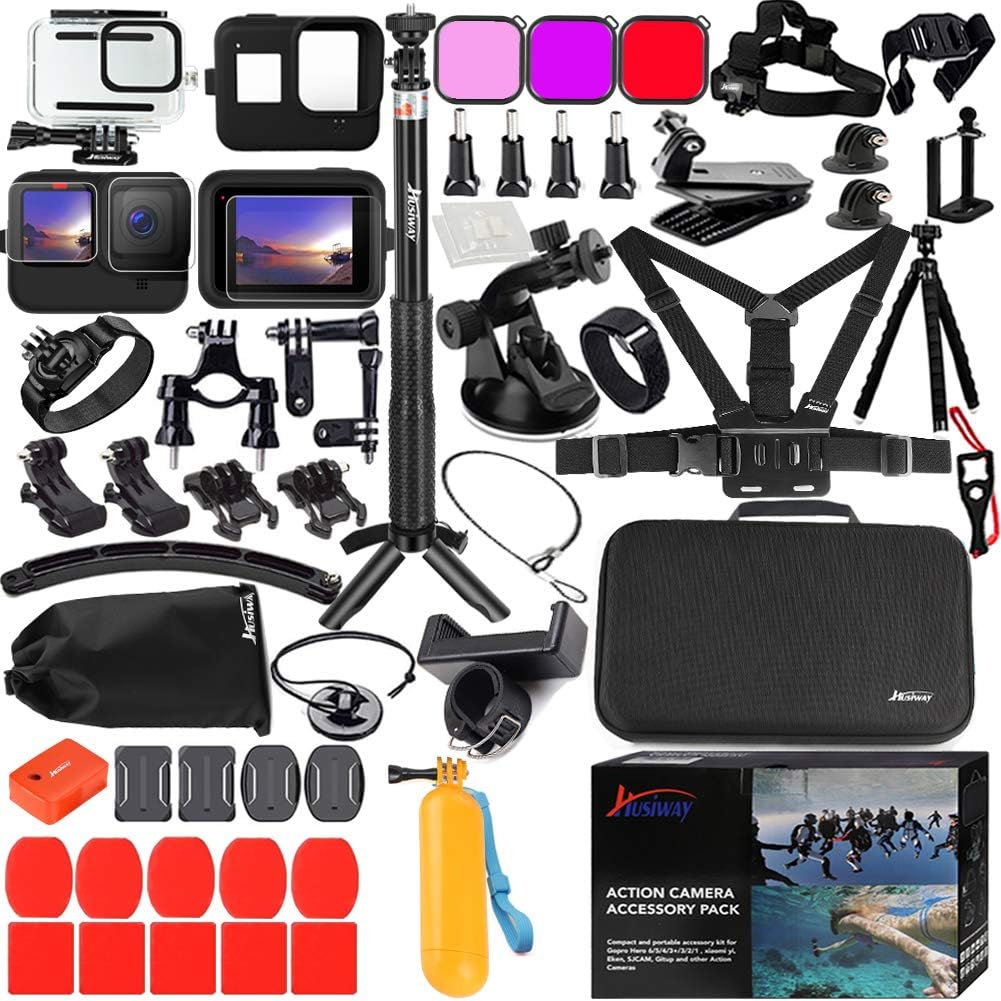In the ever-evolving world of photography, having a reliable tripod can significantly enhance the quality of my shots, providing stability and flexibility in various shooting conditions. As we look ahead to 2024, I’ve researched and compiled a list of the top five must-have camera tripods that cater to varying needs and budgets. Whether I’m a professional photographer or an enthusiastic hobbyist, these tripods offer the essential features and durability needed to elevate my photography experience. Here’s a closer look at the options that stand out this year.
Torjim 74” Extendable Camera Tripod
The Torjim 74” Camera Tripod offers impressive versatility and compatibility with various devices, making it a perfect companion for both amateur and aspiring photographers. With its ability to extend from 20.87 to 74 inches, I can easily adjust the height to suit my shooting needs, whether I’m capturing landscape photos or engaging in low-angle shots. The sturdy phone holder and universal screw provide peace of mind, ensuring my iPhone, Android, or full camera remains securely in place during shoots.
I appreciate the thoughtful features that enhance my photography experience, such as the quick-connect wireless remote that allows me to capture images from a distance of up to 33 feet. The durable construction, crafted from advanced aluminum alloy and ABS resin, assures stability even in challenging conditions. Plus, the tripod’s compact design and included travel bag make it convenient to transport for outdoor adventures or indoor events alike. Overall, I find this tripod to be an excellent value that meets my photography needs without breaking the bank.
Amazon Basics 50" Lightweight Tripod
The Amazon Basics 50-inch Lightweight Camera Mount Tripod Stand is an essential accessory for both budding photographers and seasoned professionals. Its adjustable height, ranging from 16.1 inches to a full 50 inches, offers impressive flexibility, allowing me to capture a wide variety of scenes with ease. Weighing just 1.23 pounds, this tripod is constructed from lightweight aluminum, making it incredibly portable for travel, hiking, or camping. Additionally, the built-in bubble level ensures precise alignment, allowing me to achieve consistently straight and level photographs.
What truly sets this tripod apart is its intuitive design and user-friendly features. The 3-way head facilitates easy tilt and swivel motion to switch between portrait and landscape modes, while the quick-release plate makes transitioning between shots effortless. Encased in a convenient carrying bag, the tripod is easy to transport, meeting the needs of anyone looking for a reliable and affordable photography tool without compromising on quality or performance. Overall, I find this tripod to be an invaluable addition to my gear, particularly for those seeking versatility on a budget.
Victiv 74” Heavy Duty Camera Tripod
The VICTIV Tripod 74” is a versatile and durable choice for photographers and videographers alike, offering an adjustable height range from 19 to 74 inches. Its robust aluminum construction provides the stability needed for both indoor and outdoor shoots, ensuring that I capture sharp images every time. The included carrying bag makes it easy to transport this compact tripod, weighing in at just 3.14 lbs, whether I’m shooting landscapes or portraits.
This tripod is compatible with a wide array of devices, including DSLRs, SLRs, and smartphones, thanks to its standard 1/4″ screw mount and 360° phone holder. The professional 3-way pan head allows for smooth panning and tilting, while the non-slip pads enhance grip on various surfaces. While it may not support the heaviest equipment, its exceptional value and reliability make it a perfect addition to my photography toolkit.
Gray Aluminum Tripod with Phone Holder
The 74-inch Camera Tripod is a remarkable blend of versatility and portability, designed to accommodate both mirrorless and DSLR cameras, as well as smartphones and GoPro devices. With an adjustable height range from 20 to 74 inches, it easily adapts to various shooting situations, while its lightweight aluminum construction and compact foldable design make it a perfect travel companion. Weighing only 2.8 pounds, I appreciate how it can support up to 8.8 pounds without compromising stability.
This tripod excels in functionality with its smooth 360° head adjustment, allowing me to effortlessly align my shots. The durable engineering plastic and aluminum alloy construction ensure reliability, even in mild outdoor conditions. Whether I’m capturing moments at events, vlogging, or participating in virtual meetings, this tripod has consistently met my needs with ease and stability, making it a fantastic investment for anyone seeking a durable and user-friendly solution.
JOILCAN 74" Heavy Duty Camera Tripod
The JOILCAN Tripod is a fantastic option for both amateur and professional photographers alike. Weighing just 3.15 lbs and extending up to 74 inches, it offers exceptional portability without compromising on stability. With its upgraded trapezoidal flap lock design, I can easily adjust the height from 19 to 74 inches for various shooting scenarios, making it a versatile companion for travel, hiking, or even family gatherings.
What truly impresses me is its compatibility and sturdiness. I appreciate the quick-release plates and phone holder that allow seamless transitions between my DSLR and iPhone. The built-in rubber feet grip well on diverse terrains, ensuring that my shots remain steady even on uneven ground. Overall, the JOILCAN tripod provides an excellent blend of durability, functionality, and affordability, making it a valuable addition to my photography toolkit.
Explore Your Options
Essential Questions About Camera Tripods
When choosing between a ball head and a pan/tilt head for your tripod, several factors come into play based on your specific photography needs and shooting style.
- Versatility: Ball heads are known for their versatility and ease of use. They allow for quick adjustments and can rotate in all directions with a single control knob. This makes them ideal for a variety of shooting scenarios, including landscapes, portrait photography, and time-lapses.
- Precision: Pan/tilt heads, on the other hand, offer greater precision for specific adjustments. They typically have separate controls for panning and tilting, which can be beneficial for tasks that require fine-tuned positioning, such as when shooting video, where smooth panning is crucial.
- Weight and Size: Ball heads tend to be more compact and lighter compared to pan/tilt heads, making them a favorable choice for travel and outdoor photography. If portability is a significant factor for you, a ball head might be the better option.
- Stability: If stability is a key concern, particularly with heavier equipment, a pan/tilt head can provide a more stable platform as it distributes weight more evenly.
- Personal Preference and Style: Ultimately, it comes down to your shooting style and personal preference. If you prioritize speed and flexibility, a ball head might be suitable. However, if you often engage in precise framing and control, a pan/tilt head could be more beneficial.
In summary, consider what kind of photography you’ll be doing most often and how you prefer to work. Testing both types of heads, if possible, can also help solidify your decision.
Maintaining and caring for a camera tripod is essential to ensure its longevity and optimal performance. Here are some practical tips based on best practices:
- Regular Cleaning: After each use, I wipe down the tripod legs, especially the joints and locks, to remove dirt, sand, or moisture. I use a soft cloth or brush to clear off debris, and for stubborn spots, a damp cloth followed by a dry one works well.
- Check for Damage: I frequently inspect the tripod for any signs of wear and tear, such as cracks in the legs or damage to the quick-release plate. Addressing any issues promptly can prevent further damage.
- Lubricate Moving Parts: I apply a light lubricant to the tripod’s hinges and locks as needed. This helps keep them operating smoothly. However, I ensure that I don’t over-lubricate, as excess lubricant can attract dust.
- Store Properly: When not in use, I store the tripod in a dry place away from extreme temperatures. I also consider using a protective case to shield it from potential impacts and environmental factors.
- Avoid Overloading: I always check the weight capacity of my tripod and avoid exceeding it. Overloading can damage the tripod structure and affect stability.
- Use the Right Technique: When setting up and adjusting the tripod, I ensure that I do so gently. I avoid sudden movements that can stress the joints and locks.
- Use Feet Accessories: Depending on the surface I’m working on, I utilize rubber feet, spikes, or sandbags to enhance stability. This also reduces wear on the tripod legs.
By following these tips, I can help ensure that my tripod remains in good working condition for many photography sessions to come.
Choosing the right tripod for your camera involves several important considerations to ensure stability, flexibility, and compatibility with your specific needs. Here are the key factors I recommend you evaluate:
- Camera Compatibility: First, check the weight and size of your camera. Tripods come with different weight capacities, so it’s crucial to select one that can support your camera’s weight, including any additional accessories like lenses or battery grips.
- Type of Photography: I consider the type of photography I intend to pursue. For example, if I’m doing landscape photography, a sturdy tripod with a good height range is essential. Conversely, for travel, I might prefer a lightweight and compact tripod that is easy to carry.
- Head Type: Tripod heads come in various types: ball heads, pan-tilt heads, and gimbal heads. I assess what type of movement I need. For quick adjustments, a ball head may be best, while a gimbal head works well for heavier equipment and smooth tracking movements.
- Material: The material affects both the weight and stability of the tripod. Aluminum tripods are more affordable and durable, while carbon fiber models are lighter and absorb vibrations better, which can be helpful for long exposures.
- Height and Stability: I also consider the height range of the tripod. It should be tall enough for my needs without requiring me to crouch or bend. Stability is crucial, so I look for features such as leg locks, a center column that can be reversed, and a hook for adding weight for added stability in windy conditions.
- Budget: Finally, I set a budget. While higher-priced tripods often offer better features and materials, there are many quality options available at various price points. I balance my needs with my budget to find the best value.
By evaluating these factors, I can select a tripod that suits my specific camera type and photography requirements effectively.













I wish there was a budget-friendly option listed. Anyone have recommendations for a cheap but good tripod?
Nice roundup! I love the feature comparison. Gonna save this for when I upgrade my gear.
I’ve been eyeing that ABC tripod forever! Is it really worth the price?
Just got the XYZ tripod from the list and it’s a game changer! Super steady!
Do you think the lightweight tripods are sturdy enough for heavy cameras? Love to hear thoughts!
Can’t believe how many options there are now for tripods. Which one do you guys think is the best for travel?